There are over 900 different species of Angophora, Corymbia and Eucalyptus and 750 Acacia species which always undermine the confidence and determination of scientists and enthusiasts to tackle their naming especially in the field. In this section I have endeavoured to unravel the key points in a simple 4 step process that will allow even the amateur to identify at least the Myrtaceae family in the field with a lap top or probably a mobile phone in the future.
For quick analysis and identification of Angophora sp., Corymbia sp. & Eucalyptus sp. in the field look at the following features: The bark, leaves, flowers and or fruits. This guide should be able to break the search down to1 to 6 plants with fair accuracy. From here a little more investigation on the specific species names will deduce the exact specie being studied.
The first step in correctly identifying Angophora species, Corymbia species or Eucalyptus species in the field is to know which biological zone or region you are in. After establishing the fact that the tree is native to that zone which you are in, the type of bark on the tree needs to be identified.

The bark is an important characteristic in distinguishing Angophora sp. Corymbia sp. and Eucalyptus sp.. The bark is the dead layer from the previous season’s growth that surrounds the trunk and branches. In about 50mm of the species the outer layer is completely decorticating meaning it is completely discarded by the tree. This exposes the new layer of living bark below which is smooth, chalky, or at times brilliantly coloured. The dead bark from these trees is decorticated in large patches, small flakes, long ribbons or short ribbons but always leaving a smooth appearance. The minnirich barks are decorticated in long narrow, longitudinal ribbons partly adhering to the trunk and curling outwards, longitudinally at the edges away from the trunk giving an interesting characteristic. These species are restricted to Western Australia but can be typically seen in a few Leptospermum species along the east coast.
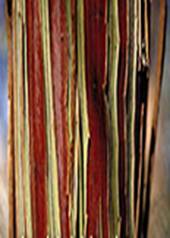
The bark can be shed all at one time as is found in many of the ghost gums which are known as the Smooth Bark Gums, over several weeks or at various times over the year which gives rise to the Mottle Barked Gums. At times the under bark is invaded by various arthropods which give the characteristic that Mr. Squiggle and Miss Jane have been around. Many of the smooth bark Eucalyptus species may display slight insect presence to heavy infestation of insect damage or scribbles on the truck and are known as the Scribble Gums.
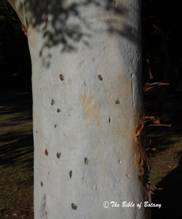
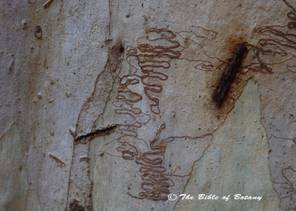
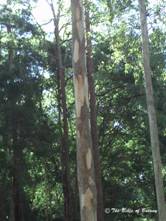
In another interesting trait of some smooth gums is that the long strips of dead bark are decorticated imperfectly which causes them to be come entangled in the forks of trees or remain loosely attached especially along the branches, trunks and near the base as is the case in the Ribbon Gums.
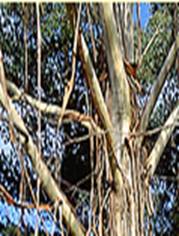
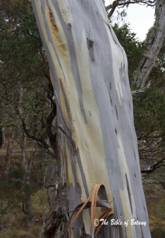
Before entering the realm of the confusing rough barks, the rough barks can be as little as a meter high stocking or may extend to the smaller medium branches. Those known as Half Barks have less than half of the lower trunk’s height covered in a rough bark while the upper section and branches are generally of the smooth gum type.
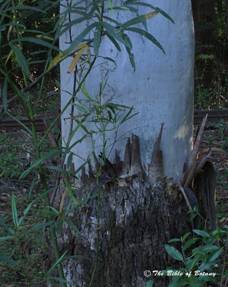

Those that may have a rougher texture other than smooth bark are often referred to as the Box Gums where the bark may be a short stocking or extend up to the lower branches. Tessellated barks are also usually known as half barks as they often have a stocking of hard rough tessellated bark on the basal 1 to 6 meters but can also extend to the full length of the trunk. The word tessellated means to be laid like square or rectangular tiles.
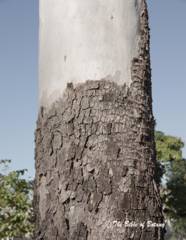
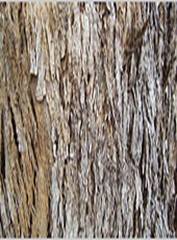
Stringy barks & Iron Barks are the typical rough type barks. The rough bark may cover just the trunk or extend to the smaller branches in rare cases. At times the branches may be like a smooth gum with the bark decorticating on a regular basis. These species are difficult to distinguish as the bark may vary in colour and hardness and structure even on the same specie within the same district and can only be used as a rough guide; excuse the pun, as one form blends into the next. A good example of confusion arises in Eucalyptus parvula where the bark is shortly fibrous and acts more like a smooth gum but is actually short fibres and decorticates annually to the ground. Again Eucalyptus perriniana is a half bark in older trees but is often seen as a smooth gum on younger trees. In these situations I have placed the tree in both categories for easier and quicker classification.
Some species just do not want to play ball and no other tree exemplifies this more than Eucalyptus melliodora. Eucalyptus melliodora does everything in its power to confuse the best botanist and has recently been divided into several new subspecies. The variation in bark is just the start as the buds, calyptras and fruits all very as well.
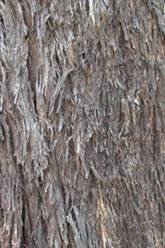

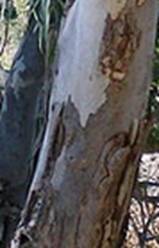
Some of the variations in the barks of Eucalyptus melliodora.
Left a stringy bark form, middle a fibrous bark form & right a mottled-half bark form.
Here the outer bark decorticates in small usually linear increments and desiccates on the trunk or branches leaving the natural linear needle like cells to accumulate throughout the year usually without falling from the tree to form the Stringy Barks as we know them. Fibrous barks have shorter more compact fibers and are an intermediate group between smooth barks and stringy barks and often cause confusion. I have grouped them under stringy barks as you will see in the next paragraph.
These fibers may remain loosely intertwined as in stringy barks or the can become infused with gum exudates which harden, resulting in the Ironbarks or intermediate forms known as Flaky Barks or Fibrous Barks. Consequently there is a great variation in blending types, within hardness, colour and structure of the barks. Below are 3 typical well defined forms. On the left is a fine stringy bark while in the center is an intermediate fibrous bark and to the right is a typical well defined iron bark.
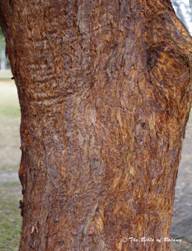
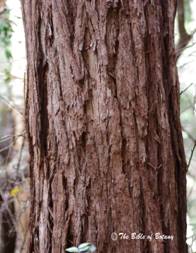
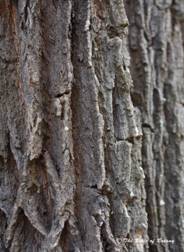
As a result I have classified the Angophora species, Corymbia species & Eucalyptus species into 9 distinct bark types. I have combined the tessellated and boxes together as their barks vary from a short to long stockings, to almost covering the full trunk. I have separated them from the half barks which I have defined as having smoother barks on the upper section of the trunk. The stringy barks and Fibrous barks are also combined as at times it is almost impossible to differentiate if a bark is smooth/fibrous, purely stringy or fibrous/iron bark in nature and can vary even on the one specie. The well defined Iron barks as such have been grouped separately. There fore the 9 groups can be found as:
In brief:
Minnirich Unique barks from a limited number of species found in Western Australia.
Smooth Gums Barks without many or usually with few blemishes.
Mottled Smooth Smooth barks with a mottled appearance.
Scribbly Gums Smooth barks with or without a mottled appearance with extensive insect damage.
Ribbon Gums Smooth barks with or without a mottled appearance where the decorticated bark is extensively trapped between the branches or forks
Half Barks Is where the bark is of one form near the base; usually rough and another form at the apex of the trunk but does not reach the branches.
Tessellated & Box Barks where the bark has a definite tessellated or tiled appearance or has another pattern.
Stringy Barks & Fibrous barks that have a needle, stringy or fibrous appearance.
Iron Barks Barks that have a strongly furrowed appearance where the fibers are no longer visible
Eucalyptus and Corymbia specie’s flowers always have an operculum/calyptra or cap which usually cleanly discarded prior to the stamens fully emerging, where as Angophora flowers have tightly gripping sepals which cover the stamens.
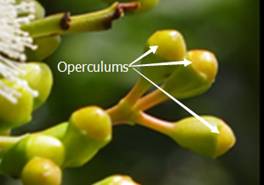
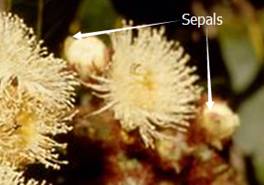
Angophora and Corymbia flowers occur usually as terminal “corymbs” where the flower’s stalks rise from different levels along the rachis with all the flowers finish in more or less the same plane due to the different lengths of the pedicels. Most Corymbia species have compound corymbs which have 3, 5, or 7 flowers on each of the individual umbels.
Eucalyptus specie flowers are usually born as simple umbels from the leaf axils and usually appear as 3, 7, 11, or 15 individual flowers or rarely 1, 2 or more than 15.
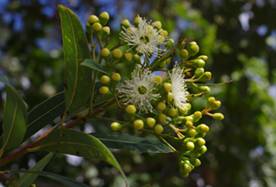
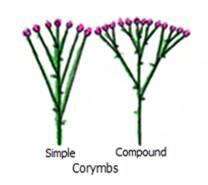
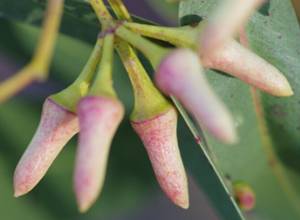
The shape of the buds and operculums/calyptras are very important tools in distinguishing the differences in the specific species. Readers should make themselves acquainted with the terminologies and the various structures of the flower buds and calyptras. Below are the basic 14 shapes of the buds and calyptras with the position of the scar when present and the typical rostrate position and shape.
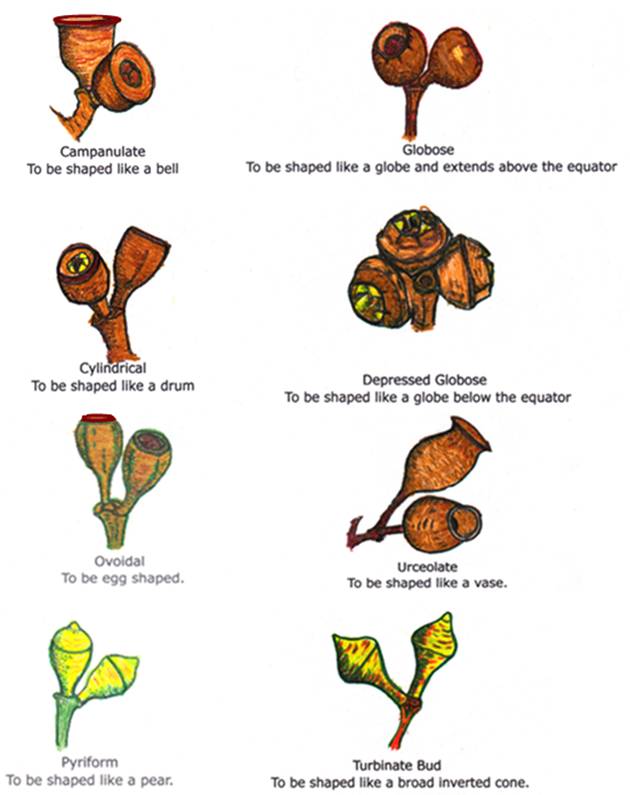
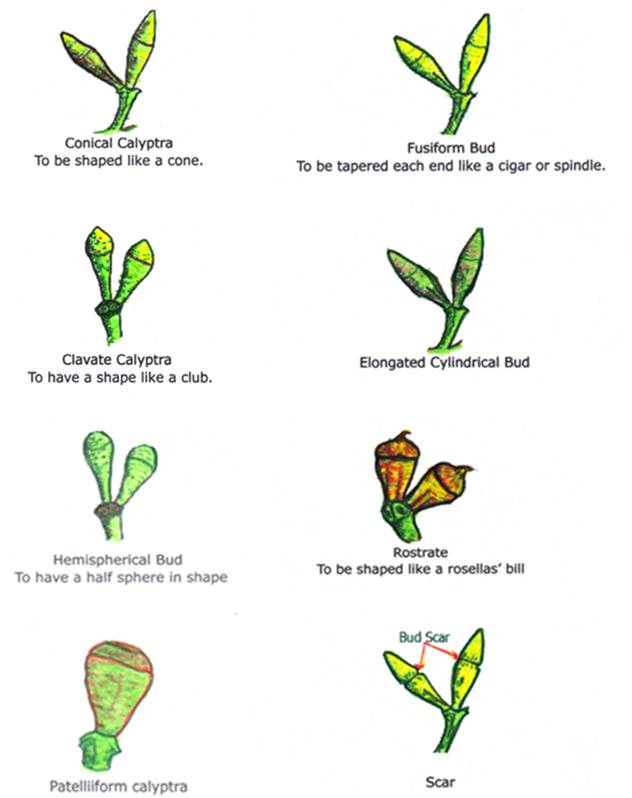
Note I have only used the adult foliage when classifying species in the wild as often the juvenile foliage or coppice growth is not available. Generally Eucalyptus species and Corymbia species; adult leaves, are alternate where as the leaves on Angophora species are opposite. There are rare exceptions as is found in Eucalyptus acmenoides which has opposite leaves. Where the leaves are opposite they are mentioned as opposite immediately following the leaf shape. Falcate refers to a leaf that has a curved midrib when the leaf is laid out flat.
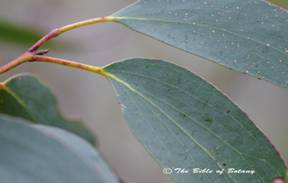
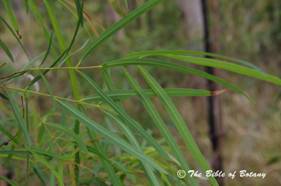
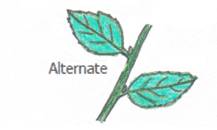
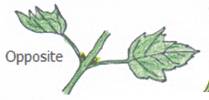
While the list may look large and unyielding it is a guide and once a decision has been made the tree or shrub can be looked studied further to ensure a correct identification has been made. Many plants are under several districts and are also included in several groups to make the task easier and to cover areas where properties may overlap. That is a plant whose bark may resemble both a smooth gum and a ribbon gum or mottled gum has been placed in each of the categories for simplicity and ease of tracing the species.
Once an initial identification has been made further reference of the species should be cross checked to species either on this web site or from the AVH web sites for further clarification. It is my intention to describe all the Eucalyptus species in Australia but first it is my intention to photograph all the species in New South Wales mentioned on this web site.
If for any reason you think I have erred then please do not hesitate in contacting me so I can modify or rectify our error/s. Only a fool believes he is correct all the time.
Note photographs are placed below their names and descriptions
No operculum/calyptra leaves opposite Go to Angophora
Has an operculum /calyptra Go to step 2
Step 2
Flowers in corymbs Go to Corymbia
Flowers in umbels Go to Eucalyptus
Bark Flower Nos. Shape Shape – Fruit Leaf Shape
Type Nos. Bud-, Calyptra-, Gum-Nut, Lanceolate
New South Wales & External Territories
Further Comments From Members:
All information is included in good faith and has been thoroughly researched prior to printing. The website or the author does not warrant or guarantee the accuracy of any information on these pages, nor does the website or the author accept any responsibility for any loss arising from the use of the information found within. The views and opinions are strictly those of the author or those members who chose to actively participate in the contents herein.
Membership agreement prohibits any reproduction, copying; other than for personal use, redistribution, electronic, paper or otherwise, including on the World Wide Web, in whole or in part, is strictly prohibited without the express written permission of the author or member contributor.